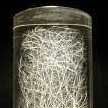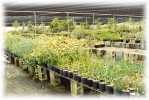Electron Beam
Electron beam is a ray of electrons created by an electron accelerator, just like the one you have at home, the TV. However the electron beam used by Acsion is 1,000 more powerfull. It can be used in all kinds of applications, from sterelization of food and biological hazard waste to creating and improving new materials like plastics and composites.
The e-beam technology is being used to create most of the parts of the Xof1 solar car, like the solar car body and frame (base) to parts, including the wheels.
Acsion helps a wide range of industries to develope new products and technolgy. Bellow are just a few examples of that they can do. To learn more about Acsion and e-beam go to www.acsion.com
Lightning Strike
 Electron treatment has been used to create the distinctive lightning strike in plastic. Using our accelerator facility, Acsion generates a very high electrical charge in a specially designed plastic cylinder. This electrical charge is then "sparked" to one end of the cylinder. The electrical current is high enough to melt the plastic, creating a one of a kind lightning strike.
Electron treatment has been used to create the distinctive lightning strike in plastic. Using our accelerator facility, Acsion generates a very high electrical charge in a specially designed plastic cylinder. This electrical charge is then "sparked" to one end of the cylinder. The electrical current is high enough to melt the plastic, creating a one of a kind lightning strike.
Atomic Golf Ball
 Acsion has developed the atomic golf ball using this unique EB treatment. It has been suggested that the process alters the molecular structure of the ball’s core, allowing it to store energy more efficiently and bounce further. Although there is no visible difference compared to an untreated ball, the atomic golf ball does indeed appear to have more bounce, as confirmed by the U.S. Professional Golf Association. As with all products treated with electrons, the atomic golf ball is completely safe to handle and use.
Acsion has developed the atomic golf ball using this unique EB treatment. It has been suggested that the process alters the molecular structure of the ball’s core, allowing it to store energy more efficiently and bounce further. Although there is no visible difference compared to an untreated ball, the atomic golf ball does indeed appear to have more bounce, as confirmed by the U.S. Professional Golf Association. As with all products treated with electrons, the atomic golf ball is completely safe to handle and use.
Thousands of golfers around the world now use the atomic golf ball, either because of its novelty or because they believe it does travel further. Whatever the case, the atomic golf ball will certainly take nothing away from your game.
E-Soil
 Electron treatment of E-soil ensures that all of your home and garden plants have the best available soil, free from unwanted seeds, insects, viruses or bacteria. Give your plants the best possible start.
Electron treatment of E-soil ensures that all of your home and garden plants have the best available soil, free from unwanted seeds, insects, viruses or bacteria. Give your plants the best possible start.
Waste Treatment
EB treatment is a current industrial process for handling many different waste streams, including sewage, animal wastes, biologically hazardous wastes, potable water, organic wastes, and acid-rain-producing stack gases. EB treatment kills harmful bacteria, and reduces odour in many waste streams. These effects have been confirmed at all of the current industrial treatment facilities, including the EB sewage plant in southern Florida. The sludge can then be safely spread over fields without the danger of contamination. EB treatment can also be used for purifying drinking water, as well as for agricultural waste and industrial aqueous effluent. ACSION will strongly promote this technology in Manitoba. focusing initially on hog waste
Viscose Manufacturing
The viscose (rayon) industry consists of over 130 mills world-wide, with a total annual production of approximately 3.2 million tons. In the viscose industry, wood pulp is treated with high concentrations of toxic chemicals to convert it into a liquid called viscose. This liquid is then converted back into fibre, filament, cord, casing, or film. These viscose products are then used to manufacture a variety of consumer and industrial products, including clothing, tire cord, personal hygiene products, packaging material (cellophane(), and reinforcing materials.
In the viscose/rayon process, cellulose wood pulp is treated with high concentrations of toxic chemicals to produce viscose. The viscose industry suffers from a number of problems which include high processing costs and environmental pollution. The high concentrations of hazardous chemicals used in the process generate effluents that are harmful to the environment. The industry is facing increasingly stringent environmental regulations that could force several companies to close within 5 years. We have been working with key players in this industry to demonstrate the benefits of using EB treatment to address these problems. EB treatment of the wood pulp makes it easier to convert the pulp to viscose, and, under optimum conditions, can reduce chemical consumption in the process by 25 to 40%. With lesser amounts of chemicals used, correspondingly less effluent is produced. For plants producing 50,000 tons of viscose per year, this translates into savings of $3 to $5 Million U.S. per year in chemical costs, with equally significant benefits for the environment.
ACSION staff play a unique role in developing this technology for the viscose industry. Based on our results, one viscose company, in collaboration with us, conducted a successful mill-scale trail in 1996 to optimize conditions at the plant scale. This company is presently involved in a second marketing trial using 800 tons of electron-treated pulp. We are also involved with several other viscose companies to optimise conditions in their plants for using electron-treated pulp.

